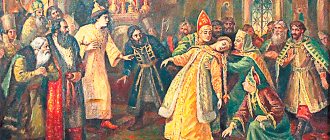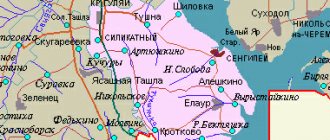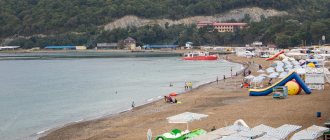Romain Rolland once said: “Only he can love the earth who healed it with his feet.” He believed that not a single book could give a person, especially a philologist, what travel gives. This is probably why my friends, writers and philologists this summer rushed to travel around their native land, discovering new and new cities. Gorokhovets in the Vladimir region holds a confident lead among these cities. Tourists have not yet learned about its charms en masse, but writers have. Three posts about the delights of Gorokhovets appear on my feed every week.
“This is not a folklore village,” historian Mikhail Korobko . “Everything is simple, provincial, but they don’t look at tourists as prey.”
And he turned out to be almost right.
Gorokhovets. Fragment of a postcard (reproduction).
Sights of Gorokhovets on the map
Gorokhovets is one of the oldest cities in the Vladimir region, which has preserved in a small area 7 luxurious merchant chambers of the 17th century (the fourth place in Russia in terms of the number of surviving civil buildings of this era - more only in Moscow, Pskov and Vyborg), as well as churches, which are luxuriously decorated and the richness of history can rival Vladimir itself - the regional center of the region in which the city is located. On an area of just 13 km2 there are almost two hundred architectural monuments , a quarter of which are of federal cultural significance. Very often, Gorokhovets serves as a location for filming films about pre-revolutionary Russia , and its picturesque landscapes have been attracting artists from all over Russia for more than two hundred years.
Gorokhovets is located on the right bank of the Klyazma on a natural hill - it is not surprising that
the first settlements in this strategic location appeared in the 6th century . Their owners were Finno-Ugric tribes, which by the 10th century were ousted and assimilated by the Slavs, who turned a small fishermen's settlement into a real fortress by the 12th century. Most likely, the permanent settlement was founded in 1168 by Andrei Bogolyubsky (the official date from which the city traces its history) during a campaign against Volga Bulgaria. But the first chronicle mention dates back to 1239 , when Gorokhovets was burned by Tatar-Mongol troops.
The etymology of the name “Gorokhovets” is still controversial among historians. On the one hand, the toponym may go back to the Finno-Ugric dialects - “Horrohoves” translated into Russian means “Village Dormant in the Snow.” But the most common version is that Gorokhovets goes back to the Slavic Gora-khovets (Mountain-grave) - the historical tract was located on modern Yarilina Mountain.
The revival of the city began during the Golden Horde - in addition to the fortress, trade and craft shops appeared. In general, the city was located on the border - first with Volga Bulgaria, then with the Kazan Khanate - and acted not only as an outpost, but also as a customs center for Russian principalities that collected duties from trade caravans. At the end of the 14th century, Gorokhovets became part of the Moscow Principality and also became a religious center for the spread of Christianity to the east . In 1352, the monastery of Basil of Caesarea was founded (subordinate to the Suzdal Spaso-Efimiev Monastery), and later the hermitage of St. George (subordinate to the Trinity-Sergius Lavra).
In 1539, the city experienced an attack by the Kazan Tatars, but quickly recovered - in 1545, Gorokhovets successfully withstood the siege and repelled all attacks of the enemy troops. At the end of the 16th century it became a county town. After the Time of Troubles, Gorokhovets lost its strategic defensive importance, but received a powerful impetus for the development of trade and handicrafts. By the 17th century, the merchant dynasties of the Ershovs, Shumilins, Selins, Sapozhnikovs, Shiryaevs, Sudoplatovs and Kanonnikovs , who became rich in trade along the Klyazma, Oka and Volga, were formed. Distillery and leather craft production is developing, and the city begins to abandon wooden buildings in favor of stone architecture - it is these buildings that have survived to this day and attract thousands of people to the small provincial modern Gorokhovets.
The first industrial enterprise was opened in the city relatively late - in 1892, a plant for the production of metal containers, ships and other metal structures began operating. At this enterprise, of its time , Marfa Posadnitsa was launched , designed by the famous engineer Vladimir Shukhov (he would later become the author of the famous Shukhov Tower in Moscow and the founder of the mesh shell technology in the construction of buildings).
During the years of Soviet power, the city continued its development as a shipbuilding center of the Vladimir region - after the Great Patriotic War it began to produce sea vessels. In addition, Gorokhovets received the largest lifting and transport equipment plant in the region, which produced overhead cranes, conveyors, hoists and other products. In 1970, Gorokhovets was included in the list of historical cities of Russia , which gives the city a powerful impetus in the development of domestic tourism. In 2010, Gorokhovets was included in the list of historical settlements of federal significance, and in 2017 it was included in the tentative list of UNESCO World Heritage Sites .
How to get to Gorokhovets
The small ancient city is located in the very south of the Vladimir region. You can get there from Moscow either by train (from the Kursk station), or by car, and even by bus from the Shchelkovo bus station. The road is surprisingly good; when you drive, you can’t believe the wheels.
Gorokhovets has been known since the thirteenth century, but locals are sure that much earlier, from the tenth - no, go deeper, from the ninth! By the way, if you assume that the toponym comes from the phrase “sheep peas,” you will cause a mortal insult to the residents of Gorokhovo. Despite the fact that among scientists the Slavic origin of the toponym is considered the most likely, locals support the Finno-Ugric version, which states that the word comes from “horrohoves”, which means “snow-covered village”.
Gorokhovets. Fragment of a photograph (reproduction).
House of Ershov (Sapozhnikov)
The white stone three-story palace was built in the 1680s by the richest merchant of Gorokhovets, Semyon Ershov.
The architecture of the building, similar to an ancient Russian tower, is considered the most luxurious of those that have survived to this day. Until the 18th century, the house was owned by the Ershov merchants, after which it was sold to the Shiryaev merchants, and in the 1820s the owner became the merchant Sapozhnikov, whose family were the last private owners of the luxurious chambers until 1918, when the premises were nationalized and turned into an apartment building (5 separate premises), one of which was occupied by the heirs of the famous dynasty. For a modern person, the Ershov (Sapozhnikov) house is a unique way to get in touch with the everyday life and interior of merchant life in the 17th century - now the Gorokhovets Historical and Architectural Museum is located in Ershov’s house (opened in 1981). On the first and second floors there is an exhibition introducing visitors to the bedroom and reception hall with a rich interior that only wealthy people could afford. The third floor contains a collection of toys and personal items belonging to various merchant dynasties of Gorokhovets.
Ershov's house was surrounded by a high fence with a three-meter oak gate, which has survived to this day and is the only monument of wooden architecture of the 17th century in the Vladimir region .
Address : Nagornaya st., 4, Gorokhovets, Vladimir region, 601480
Local service
The service in Gorokhovets is nice and provincial. Taxi aggregators are not working. You need to order a car using the numbers posted on the poles. Moreover, both I and my friends who met in the city had the impression that there was only one taxi driver here. He drives around in a car with the windows open and spoils the silence of the “tynts-tynts-tynts” from the nineties: “Music is playing on the ship,” “American Fight” and the like. As they say, advertising is never bad.
The food is also not varied. There are no fancy establishments with craft beer here, thank God. Some cafeterias have not yet reopened after the pandemic. The large Soviet building with the sign “Restaurant” turned out to be not a restaurant, but a liquor store. The only food outlet was a cafe, and in fact, the “Izbushka” canteen, with food served through the window. The only items left on the menu were solyanka, pancake with raspberry jam, mashed potatoes with pike perch and fruit drink. Everything is in plastic plates, but edible. The red cat sitting opposite immediately came to squeeze something out. He helped himself to bread and olives and drank the rest of the soup.
The only cafe in the whole city. Photo: Sergey SELEDKIN
We were told that the white stone chambers of the city had had a toilet almost since the 17th century. However, nothing has survived to this day. There are no public “happiness rooms” anywhere: neither on the streets, nor in cafes, nor in public places. When, after a two-hour tour (and before that, having eaten cherries hanging from the fences) at the Marfa Posadnitsa Museum, I inquired about the happiness room, in response, the museum workers shook their heads: “You understand, we have an old museum. And also a pandemic. So there is no toilet.” Reasoning what the pandemic had to do with it, I had to run a kilometer to the hotel.
Central square. Photo: Sergey SELEDKIN
Blagoveshchensky cathedral
The main and largest Orthodox church of Gorokhovets - the Annunciation Cathedral - was built in 1700 with the full financial support of the merchant Ershov, who determined its appearance and decoration. Despite the late construction time, the Annunciation Cathedral is the most “ancient Russian” in architectural terms - a five-domed temple on a rather impressive cubic base, adjoined by a 37-meter bell tower, which has become the new dominant feature of Gorokhovets. Its location was chosen more than successfully for the central religious institution of the city - between the buildings of the Trading Rows and the Gorokhovets City Duma. Until now, the Annunciation Cathedral is the tallest building in the city , which can be seen from almost every point.
In the 1930s, the temple was closed, but was not looted, like many other similar buildings. Today it is a functioning cathedral, which houses the art gallery of the Vladimir-Suzdal Museum-Reserve.
Address : Shkolny lane, 1, Gorokhovets, Vladimir region, 601480
Why go
The city bears the unofficial name of the capital of the stone chambers. It preserves a record number of white stone structures from the 17th century: as many as seven out of two dozen scattered throughout Russia.
However, I was more interested in wooden towers. I was used to the fact that houses of the Art Nouveau era were predominantly brick, and already at the entrance I was immediately struck by a wooden mansion, one of the turrets of which was made of bent logs!
On the main street of the city there are a considerable number of gingerbread houses, one more beautiful than the other: with fancy windows, wooden mermaids, colorful facades and long windows. Some have been turned into museums, and people still live in simpler houses.
Shorin's house. Photo: commons.wikimedia.org
Holy Trinity St. Nicholas Monastery
The Holy Trinity St. Nicholas Monastery is located on Puzhalova Mountain, where the first settlements were found on the territory of Gorokhovets, and where in the 12th century there was the easternmost outpost of the Vladimir-Suzdal Principality.
The monastery was founded in the 17th century by decree of Tsar Mikhail Romanov and was a small wooden temple, which was soon destroyed by a large fire. New buildings of the monastery were built of stone, and the central Trinity Cathedral was erected in 1681-1689 with donations from the merchant Sapozhnikov. Surprisingly, the main temple of the monastery has survived to this day. In the 1920s The Holy Trinity St. Nicholas Monastery was abolished, and some of the historical buildings were destroyed. An orphanage was located on its territory, and in the Trinity Church there was a warehouse for films and photographic documents. With the collapse of the USSR, the revival of the monastery began (1993), which continues to this day. Pilgrims from all over the Vladimir region and adjacent regions strive to come here to venerate one of the main shrines of the monastery - a particle of the relics of St. Sergius .
Address : Proletarskaya st., 12, Gorokhovets, Vladimir region, 601480
Where to stay
Either because the Vladimir region is still in pandemic mode, hotels turned out to be a bit tight. Booking gave three options, two of which were strongly criticized, one, but expensive, was praised. The road was called “Aquarius”, and there were only apartments left in it for five thousand rubles, but they were amazing: two rooms, a kitchen and a huge bathroom with a bidet and a jacuzzi.
— There, in the toilet, you have to press the lever twice. “It’s so cleverly designed,” the sweet aunty administrator admonished.
Unfortunately, the hotel restaurant was not open due to the pandemic, but they showed me Vysotsky’s corner set up there: Vladimir Semenovich’s guitar, a tape recorder with reels, books, cassettes. And also, approaching the hotel, I noticed jets of a fountain gushing out from under the ground, surrounding the bust of Vysotsky.
“Has Vysotsky really been here?” - I was surprised.
It turned out that no, I haven’t been, but the owner of the hotel is a big fan of Vysotsky. He made a mini-museum, a fountain and even a ski resort on Puzhalova Mountain.
Fountain "Vysotsky". Photo: Sergey SELEDKIN
House of the Shiryaevs
The most unusual Gorokhovets mansion belonged to the Shiryaev merchants, distinguished by a high level of education and good knowledge of the culture and architecture of Europe. The house, built in the 17th century, in appearance did not stand out in any way from the classic dwellings of wealthy Russians of that era - elements of Russian architecture from the Baroque. But the layout and interior of the house was done in a European style - the enfilade arrangement of rooms was extremely atypical.
The location of the Shiryaevs' house can also be called atypical - it is adjacent to the wall of the Sretensky Monastery - special thanks for their active contribution to the construction of the monastery and the Kazan Church of Gorokhovets.
The building has been preserved almost in its original form. The original design had two stone floors and the last one in wood, rebuilt in stone in the 19th century. In 1980, the Shiryaev house underwent a major reconstruction, during which all the lost decorative elements of the facade were returned. Now it belongs to the Sretensky Monastery, but no one will bother you to go to the territory adjacent to the house and get acquainted with the facade of the building.
Address : Sovetskaya st., 9, Gorokhovets, Vladimir region, 601480
Morozov's House
Gorokhovets is not only about stone mansions of the 17th century, but also magnificent wooden architecture in the Art Nouveau style of the early 20th century . Such monuments include the Morozov House, built at the beginning of the 20th century by the shipowner and merchant Shorin and donated to his son-in-law, the merchant Morozov. The building is a one-story structure of light green color with turrets on the roof and a large number of carvings in the decoration of the facade .
On a clear sunny day, despite some “fatigue,” Moroz’s house looks like a fairy-tale tower among the majestic stone buildings of Gorokhovets. Currently, the building is used for administrative purposes - a children's library is located on its premises.
Address : st. Lenina, 83, Gorokhovets, Vladimir region, 601480
About interesting things
Although it is indecent to look into other people's windows, it is difficult to resist. A distinctive feature of the city is the incredibly beautiful wooden carvings made by Yakush carpenters living in the neighboring village of Yakushevo. The Yakushi were famous throughout the country for their ability to turn wood into the finest yarn and create, as they would say now, a 3D pattern. One of the most beautiful buildings on Lenin Street is the wooden house of the merchant Morozov in the Russian style with Art Nouveau elements and scaly turrets. Now the mansion houses the “Marfa Posadnitsa” museum, named after the oil barge, the largest at the beginning of the twentieth century, made by the Gorokhovo residents. More than a hundred years ago, the place was famous for its skilled boilermakers or metal craftsmen, whose job was to hammer in rivets. This is very hard physical work, which was performed with rough tools and led to disability. The boilermakers quickly became deaf, which is why they were called wood grouse. Our first oil pipelines, the Russian metal fleet, and railway bridges, which are still standing, were made by the forces of wood grouse.
In the museum they showed us the main beauty - a model of the Shabolovskaya tower by engineer Shukhov, wrapped in a garland like a Christmas tree. Gorokhovets boilermakers riveted the tower, hanging on cables for seven hours without the opportunity to go down for a smoke break and other needs.
Museum of Marfa Posadnitsa and a model of the Shukhov Tower. Photo: Sergey SELEDKIN
At the museum we were told a terrible story about how the local merchant Semchev went bankrupt when he once cheated and made a barge out of thin iron, taking money for thick iron. After this incident, the merchant's credibility dried up, and the business was transferred to another person.
- Look at the face of the merchant Semchev. Do you believe that he had no education? And he had no education. Look at the faces of our boilermakers. How bright and beautiful. Now there are none. It's true? — the guide exclaimed every now and then.
“True, true,” the visitors politely repeated.
The white stone chambers of Ershov's House and the flail that the brownie stole. Photo: Sergey SELEDKIN
In the white stone chambers of the Ershov (Sapozhnikov) House, a monument to pre-Petrine Rus', I flatly refused the excursion and repeated three times that I would see everything myself and was in a hurry. The staff understood everything, although they couldn’t let me go without a tour at all and told me about all the rooms, but still not in such detail and not an hour for each. They took me up the stairs, in the wall of the house, showed me an amazing folk device called “prosorushka”, told me about the secret passage leading from the house to the other side of the Klyazma, and were especially inspired when I asked if there were brownies here.
- But of course! — the museum employee was delighted. - How mischievous he is. Either he will steal a floor rag, or he will place a bucket of water right under your feet so that you can kick into it. And what happened yesterday! I go down to the underground, and everything is covered in lime and there is no flail. I told him: “Antosha, don’t play around, otherwise I won’t buy you candy...” I saw that he then put the flail at the threshold.
— Do you buy Antosha sweets? - I asked.
“It happens, it’s the owner after all,” they answered me.
White stone monastery. Photo: Sergey SELEDKIN
Bald Mountain
One of the most mysterious places in Gorokhovets is Bald Mountain. which got its name due to the complete absence of large vegetation in the form of shrubs and trees .
It rises 100 meters above the Klyazma and offers picturesque views of the river floodplain, water meadows and endless forests surrounding the ancient city. Bald Mountain has attracted the attention of local residents throughout the entire known chronicle history, and the absence of large natural vegetation has given rise to many legends. One of them says that from ancient times this place was used by witches and sorcerers for the Sabbath, after the wild dances and rituals of which not even grass grows. According to another version, for a long time there was a pagan temple on the hill, which caused dark forces to kill all living things on Bald Mountain.
For a long time there was an opinion that this was a mound - in 1545, near Gorokhovets, the army of the Kazan Khan Amanak was defeated , and he himself died. He was buried with great honors, and each of his warriors brought a handful of earth. There were so many people who wanted to send their ruler on his last journey that they created a man-made hill. But, in the 1920s, as a result of archaeological excavations by O.N. Bader, it was established that Bald Mountain has a natural origin, and the first settlements began to appear here in the first millennium AD. And in the 6th-5th centuries AD there was a site for tribes who did not know metal tools - a large number of artifacts of their culture made of clay and bone have been preserved.
Address : st. Gorky, 96-106, Vladimir region, 601482
About excursions
There is a tourist information center in Gorokhovets where you can book a tour of the city.
“I have an hour of work - a thousand rubles,” announced the female guide and warned: “And I can talk for a long time.”
She spoke for a really long time, trying to throw out the wisdom accumulated over centuries. Useful information was drowned in streams of information that her grandfather loves frumchenye cookies, her grandson went to serve in the army, the age of the house, which amazes with its architecture, is undoubtedly very respectable, and that the guide herself is building a dacha, so she is in dire need of money. To leading questions, the woman answered “wait, don’t knock me down, I’ll get to that later.” Luckily for us, it started to rain, so the excursion took two hours.
“Oh, it’s a pity, I didn’t tell you the most interesting thing,” the guide sighed.
I found interesting things on my own, fortunately it turned out to be simple. Near each interesting object there are information boards with photographs and historical information in Russian and English. And while he was hiding from the rain in the editorial office of the newspaper “New Life”, located in a red-brick mansion, a local reporter showed a mammoth, which he had molded with his own hands, and told a lot of things. For example, that the abbess of the monastery started vegetable gardens and greenhouses. That director Nikita Mikhalkov has a cool stable and they ride horses there cheaply. And he also gave me two issues of Novaya Zhizn, telling me not to tell anyone under any circumstances. But I'll tell you because the newspaper is interesting. It has a circulation of two thousand copies and a staff of ten people. Which is a lot.
Sretensky Monastery
Sretensky Convent was founded by decree of Patriarch Nikon in 1658 and is located on the central square of Gorokhovets opposite the Annunciation Cathedral.
Initially, all the buildings of the monastery were wooden, but in 1689 stone construction began. The monastery did not have land holdings, and it was supported by charitable donations and through the sale of monastic handicrafts. In 1764, according to the church reform of Catherine II, the Sretensky Monastery was abolished , and the nuns were transferred to the Arzamas Monastery of St. Nicholas the Wonderworker. All buildings and premises were transferred to the balance of the city authorities. So, in the 19th century. they housed county government offices, a city prison, wine and salt shops and warehouses. In the 1930s, the ensemble of the Sretensky Monastery was classified as an architectural monument of the highest category, and restoration work began. In 2002, the convent was revived.
The following architectural monuments are of greatest value today:
- Sretensky Cathedral built in 1689. Built with donations from merchant Semyon Ershov.
- Church of St. Sergius of Radonezh, late 17th century.
- A 35-meter bell tower located above the central entrance to the monastery. Built in 1689.
Address : Sovetskaya st., 5, Gorokhovets, Vladimir region, 601480
Prishletsov's House
One of the visiting cards of Gorokhovets and the most elegant historical building of the city is the house of the merchant Prishletsov (chairman of the zemstvo government), built in 1915 in the New Russian architectural style .
The facade of the building amazes with the richness of its decor and fine woodwork - the platbands are unique works of carpentry from the early 20th century. For the plot of the frames, a grapevine was chosen, closely intertwined with exotic plants, on the branches of which mermaids and strange birds sit. The main entrance to Prishletsov’s house is decorated with a low square-shaped tower, and the roof of the building is covered with tiles and decorated with a spire. The roof of the house is also unusual - thanks to triangular dormer windows and steps rising to the ridge of the roof.
Address : st. Lenina, 38, Gorokhovets, Vladimir region, 601480
House of Arts and Crafts (house of M.I. Shorin)
A large number of civil architectural monuments of the late 19th – early 20th centuries have been preserved in Gorokhovets, but a special place among them is occupied by the house of the shipowner M.I. Shorina. It was built at the beginning of the last century according to the design of the architect Yu.F. Bruni, who managed to combine the “modern” style that was fashionable at that time with the “pseudo-Russian style” loved by many rich Russians .
The main “highlight” of the house is the graceful turrets in the corners and the smooth lines of window frames with fancy glazing. Today, in Shorin’s “fairy-tale mansion” there is a House of Arts and Crafts , opened here in 1994. Visitors can plunge into the life and culture of Gorokhovo residents, learn the basics of popular crafts and try to make a real souvenir with their own hands! There are also regular master classes on folk arts and crafts, and regular creative clubs for children and adults.
Address : st. Lenina, 18, Gorokhovets, Vladimir region, 601480
Singer Lake
The most favorite place for outdoor recreation for residents of Gorokhovets is Lake Singer, located in the village of Gashkino, not far from the city. Its length is 1.5 km and its depth barely reaches 26 meters. However, it has an amazing feature - fed by large amounts of spring water rich in silver ions, Lake Singer remains crystal clear all year round and does not bloom during the hottest period of the year.
On the shore of the lake there are several recreation centers, a beach, barbecue facilities and centralized fishing. Local waters are rich in roach, perch and even pike!
Address : Gashkino, Vladimir region, 601470










